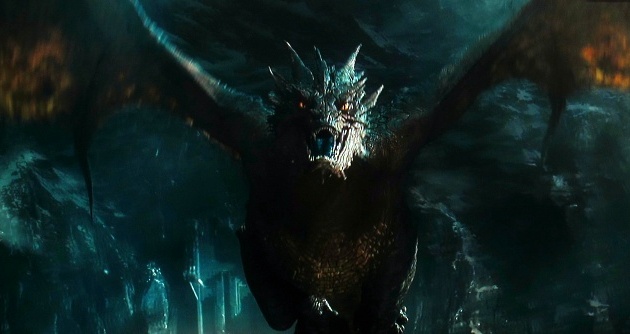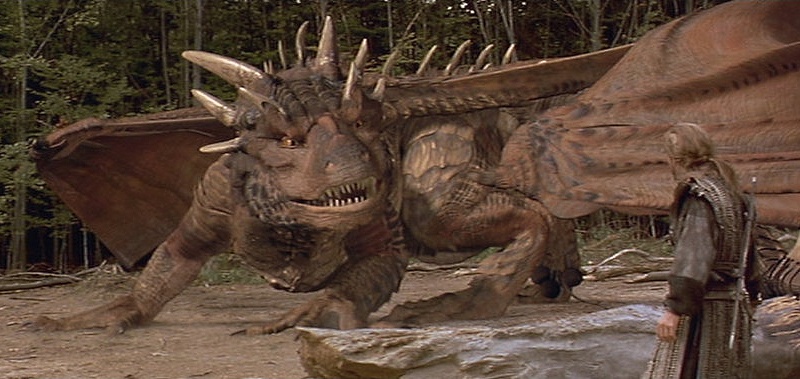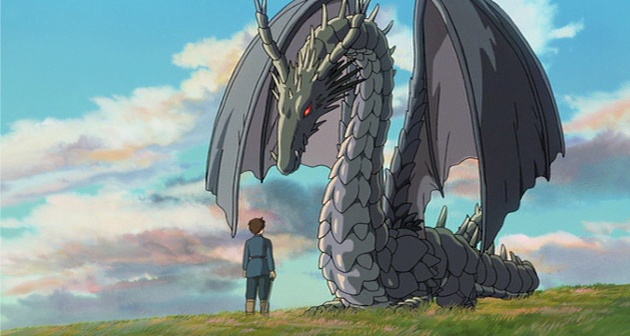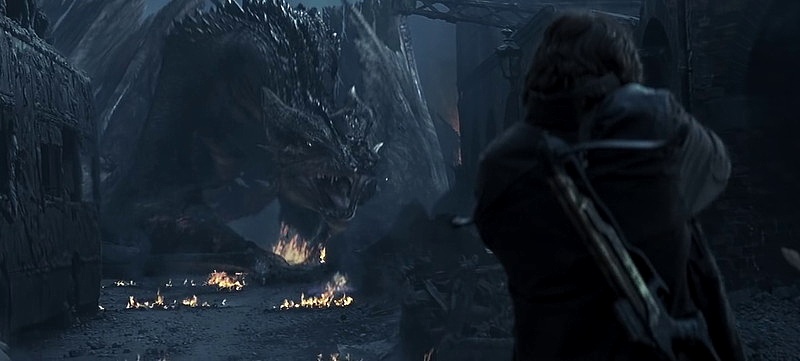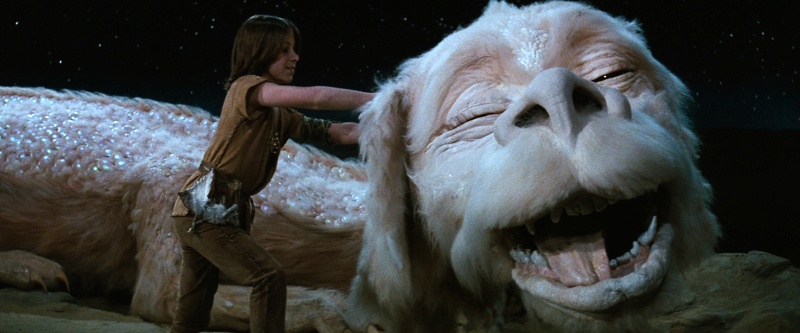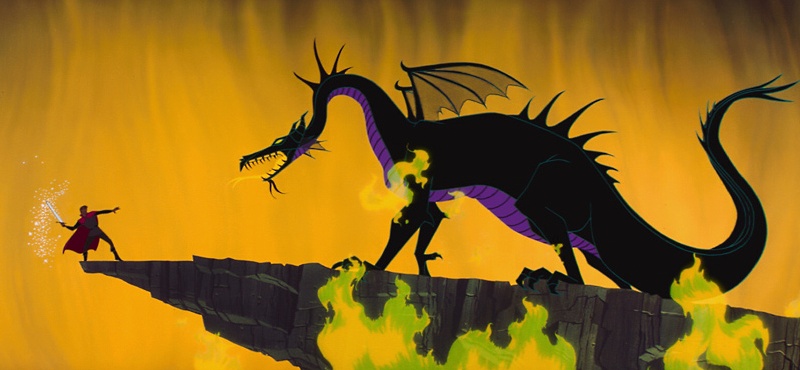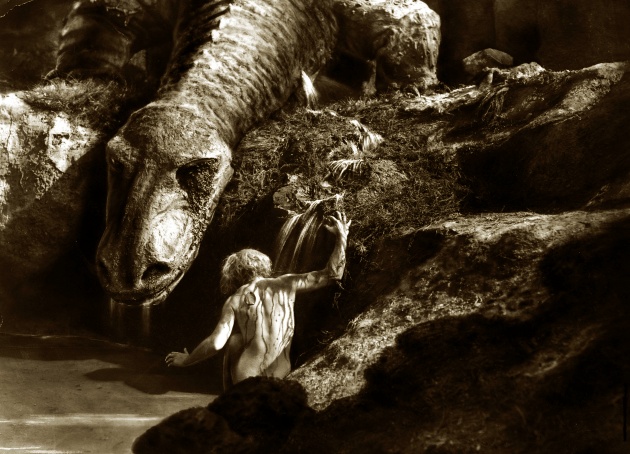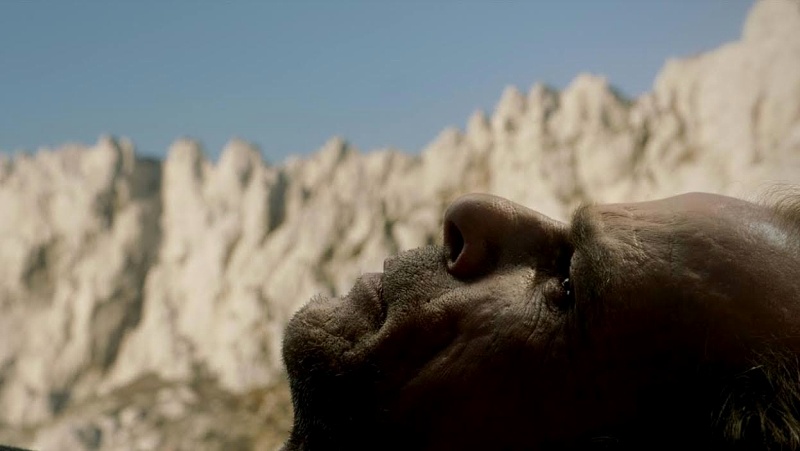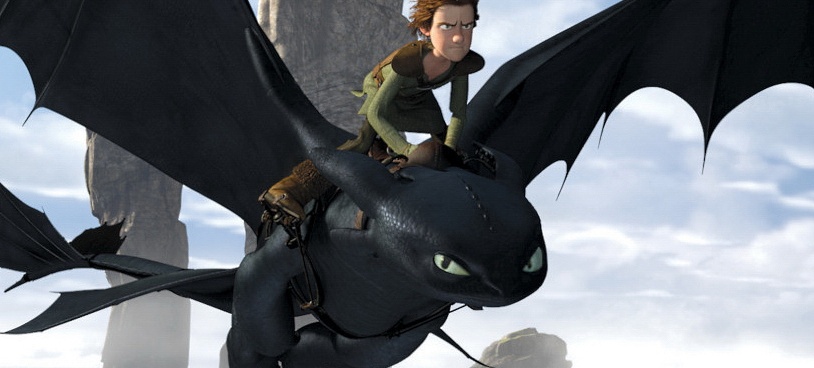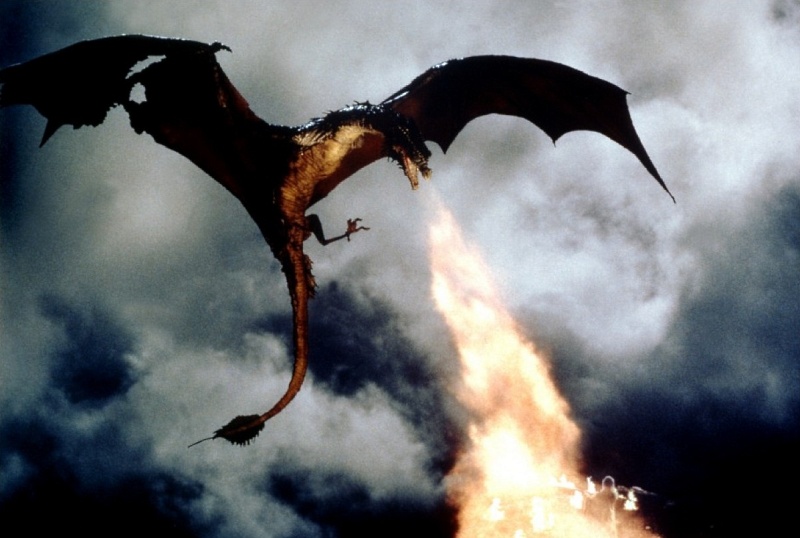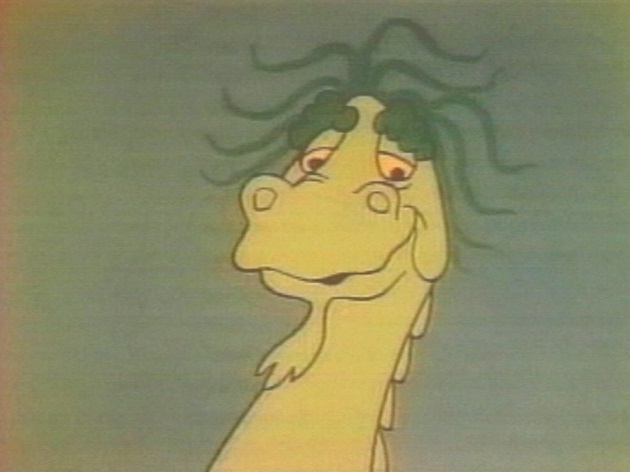Hobbitty ScreenAnarchyes: Our Favorite Film Dragons
Ah, that dragon. Say what you want of Peter Jackson's Lord of the Rings films, and his Hobbit ones, but he conjured up a great, great dragon.
And dragons are special creatures indeed, appearing in legends in all countries, albeit in a vast variety of shapes, sizes, meanings and intentions. Even dinosaurs may not be able to capture the imagination as much as dragons do. In fact, their popularity is so great, they would be a lot more common in films if they weren't so difficult to achieve. Being large and non-existent, they pose a big problem for any production wanting one. Dragons may love heaps of gold in many tales, they COST heaps of gold in real life, and often prove to become the death-knell of productions.
Still, there have been some fine examples through the ages. Here is a gallery of great movie dragons, and it's not just me doing this list: several writers within ScreenAnarchy chipped in with their favorites, some of which are surprising to say the least...
Check them all (they're in no particular order), and see if your favorites are among them. And if they're not, please tell us all in the comments which ones we missed!
Shelagh Rowan-Legg, Ernesto Zelaya Miñano, Michele "Izzy" Galgana, Patrick Holzapfel, Kurt Halfyard and Stuart Muller
contributed to this story.













And here is Smaug, setting off for Lake Town at the end of The Hobbit: The Desolation of Smaug.
In his own words: he is fire. He is death.
When Rob Cohen's Dragonheart was released in 1996, it was often described as a bad film with a great dragon, neither of which is exactly true. While the film has its flaws, it may actually be more appreciated post-Lord of the Rings. The cgi dragon hasn't aged so well though...
But at the time, just after Jurassic Park, we fantasy fans couldn't wait to see a dragon brought to life in the same way as the T-Rex, and to have it voiced by Sean Connery was a great choice. Draco worked as a character, and while he looked a bit iffy when hovering (he is not exactly a hummingbird...), the animation was great while he was swooping, fighting and walking.
Shelagh Rowan-Legg - Contributing Writer
Dragons have very different semiotic meanings in western and eastern cultures. In western (mainly European) cultures, dragons are generally cast as evil creatures that wreak havoc and exist for knights to defeat. In eastern cultures, dragons may be powerful, but are essentially benevolent creatures, with powers over earthly elements.
Tales from Earthsea is Studio Ghibli’s adaptation of American author Ursula Le Guin’s book series of the same name (the few books of hers that I haven’t read). Le Guin’s books and the film take a decidedly eastern approach to the figure of the dragon: powerful and magical creatures who once lived in harmony with humans, but who were eventually shunned as humans began to take more land.
The dragons in Tales from Earthsea only appear at the beginning and end of the film, so it might seem like an odd choice. But they are the spectre that haunts the story. Their appearance at the beginning of the film, fighting to the death with one falling into the sea, are signs of trouble ahead, that the humans have become too corrupt, and nature is dying. Their appearance at the end, saving the main character, suggests balance has been restored.
This might be why they are among the more memorable film dragons; they are somewhat anthropomorphicized in connection to children, related to magic, but this is all symbolism for connection to nature, a balance of the natural world that takes the good with the bad, that seeks a balance. Animals are not evil; they exist as they are, in survival and harmony. To loose that connection is disastrous to say the least, and in Tales from Earthsea, it is humans (mostly men) who are evil. (As a side note, Le Guin viewed the film as good, but having nothing to do with her books. But that’s something for an article on adaptation).
Another not-entirely-successful film was Rob Bowman's Reign of Fire, which had a great B-movie science fiction premise on paper, but ended up being a bit too gloomy and serious for its own sake.
In the film, those mysterious mass-extinctions which happen every hundred million years turn out to be caused by firebreathing dragons, who wake up, torch the place, eat the ashes, and go back into hibernation. The dragons in this film look absolutely fantastic, and all cgi dragons of the last decade owe a great debt to these beasties.
Ernesto Zelaya Miñano - Contributing Writer
The Neverending Story was the first movie I ever watched in theaters. At least that’s what my father says; at the tender age of four, he took me and my sisters to the theater and we ended up traumatized when the horse died. The movie made quite an impression on me, and I was jealous of Barret Oliver: I wanted to ride on Falkor the Luck Dragon’s back and toss the school bullies into a dumpster.
What kid didn’t love Falkor? A friendly, wise dragon who more closely resembled a dog with scales. Atreyu was having a dark and difficult journey; his horse dies, the land of Fantasia is disappearing all around him, and a wolf is itching to tear him to pieces. And just when it all seems hopeless, there’s Falkor to reassure us that everything will be fine, the only one who remains optimistic even as the Nothing destroys all.
Falkor is just one of the many reasons I treasure the movie. There was the Rock Biter; the Night Hob and his narcoleptic bat; that guy in the top hat with the ultra-fast snail; the giant turtle with the asthma attacks; and the Childlike Empress, who became my first screen crush all throughout my childhood.
I could relate to Bastian: a lonely kid who reads a lot. I devoured books back then and still do; and really, The Neverending Story is a thinly-disguised ode to the joys of reading, a reminder of its limitless possibilities. Today, in an age of tablets and cell phones, that message is ten times more relevant. I’m starting to sympathize more and more with the mean old bastard in the bookstore at the beginning of the film who sells small rectangular objects called books and make no bee-bee-beeps.
Show this movie to any ADD-afflicted kid today and I bet they’d all want to meet Falkor and ride on his back. There’s a reason he’s the most iconic image from this movie. You just know Hollywood will get around to remaking this eventually, and I cringe at how it’ll probably be updated for a modern generation. They better leave Falkor intact, though; you can toss out the corny 80s synth song, but don’t touch the dragon, unless he’s voiced by Liam Neeson.
Nathan Juran's The 7th Voyage of Sinbad is probably better known as... well, as Ray Harryhausen's The 7th Voyage of Sinbad. It's hard to think of another special effects artist who managed to become his own brand, but the effects Harryhausen made were at the time rightfully legendary.
Ray Harryhausen made his creature effects using stop-motion, the same technique used in, for example, the original (1933) King Kong. This means he used puppets, which he manually animated by changing their position mere millimeters, frame by frame. It's an incredibly arduous, finicky and time-consuming process, especially when done as well as Harryhausen did.
Several great monsters wander through the Levant in The 7th Voyage of Sinbad, all moving in that tell-tale jittery way stop-motion creatures tend to do. But none are greater than the huge green dragon, an evil wizard's guard-dog who, in the film's climax, fights the heroes AND a cyclops. Matinee doesn't get much better than this...
After Ray Harryhausen had a lot of success with his Sinbad film, copycats appeared all over the world. The 1963 German-US co-production Captain Sindbad (note the added D in Sindbad to avoid legal action from team Harryhausen...) sports many a camp effect and many a fun monster. The best of which enters the film near the end, when Sindbad needs to fight a totally over-the-top twelve headed fire-breathing dragon near a lake of lava.
Impressively, realizing that it would take too much time and money to animate twelve heads through stop-motion, the effects creators made this one as a movable model robot. The end result is a dragon which looks clearly fake but is still cool as hell.
It may not the most realistic one out there but c'mon! Twelve heads!
Michele Galgana - Contributing Writer
The original Sleeping Beauty was released in 1959. This animated children's film came in January, not long after Bozo and Rawhide both premiered on TV, for those lucky enough to own a set. As a film, Sleeping Beauty was innocent enough---Princess Aurora was pretty and and her Prince Phillip was a cardboard cutout of a character. Dutiful, and good and such. I'm not sure he ever spoke one word.
The real meat of the film was Maleficent, and from the first time I saw her, I was intrigued by her intense, husky voice. She spoke with purpose and real passion, unlike the other characters, and was the only developed persona in the film. Not only did she walk and talk with hateful elegance, but she had some seriously swank Gothic style---something else I'd never seen before, except in the Roger Corman/Vincent Price Poe collaborations.
Eventually, Maleficent (who was upset that she wasn't invited to what was essentially a lavish baby shower and therefore decided to curse the child) found Aurora. After the prince woke her with "true love's kiss" Maleficent got pissed off and turned into a dragon to battle the prince. For a young child, this black and purple winged dragon was terrifying --- and riveting. She snapped like a gator and spat glowing green fire. She simply cast a spell and a tangled jungle of sharp, black thorns appeared over a raging, infernal hellscape.
Talk about impressions. And she still lost, because it was a Disney film. I don't care if you had bad PR; you'll always be my first dragon love, Maleficent.
Fritz Lang's Die Nibelungen is a huge five-hour epic from 1924, the age of silent films. Rather crucial to its plot is that the hero Siegfried slays a dragon and showers in its blood, which procedure grants him invulnerability.
For those wanting to see the dragon, you need not wait long: Siegfried kills him off in the first 20 minutes already. What is really interesting though is how they did the dragon effects, because they basically didn't do any. The production team just built a real moving full-size dragon as a set piece, and its mechanical blueprint is almost as much a work of art as the film itself (click here to see...). The beast could move its legs, head, eyes, tail and belch fire.
Siegfried's dispatch of the dragon is pretty gruesome to this day: he first slashes an eyeball in half (in close-up), then punctures its chest, and the monster oozes slime and blood throughout Siegfried's bath...
Patrick Holzapfel - Contributing Writer
Denis Lavant In Journey to the West.
When I was visiting a Tsai Ming-liang retrospective earlier this year the filmmaker talked about casting French Actor Denis Lavant in his latest Journey to the West. He mentioned that he wanted to work with Lavant before and that he always wanted to cast him as a dragon because in his opinion the actor, who is famous for his collaborations with Leos Carax, looks like a dragon. And Lavant still is a dragon in Journey to the West. The menacing and powerful image of Lavant’s sleeping face, resting violently while breathing calmly and heavily reminded me of the fear I got from children books where dragons used to sleep at first while heroes were trying to move around them silently in order to not awaken them. Lavant is a gentle dragon, always smelling something and feeling movements with his cratered face of beauty. As we know from earlier films he might burst out and spit fire but more likely he just wants to touch, as he not only looks like a dragon but more like the loneliness of a dragon.
To me, How To Train Your Dragon marked a distinct point where Pixar's unchallenged superiority in computer animated feature films ended. For some time DreamWorks Animation was playing catch-up and gaining ground on the number one, and came very close to winning the battle outright with Kung Fu Panda versus WALL-E, but in 2010 we had How To Train Your Dragon versus Toy Story 3, and there was no way to determine that Pixar had undoubtedly made the better picture. A tie. One year later it was Kung Fu Panda 2 versus Cars 2, a clear win for DreamWorks Animation.
And in a film full of weird dragons of all shapes and sizes, the mis-named Toothless is a fantastic creature. Animated as something between a flying fish and a cat, he is as much a protagonist as any of the humans. Two films and two television series on, he's still great. I love him.
Kurt Halfyard - Contributing Writer
“Dragons. Once, the skies were dotted with them. Magnificent horned backs, leathern wings. Soaring. And their hot-breathed wind. Oh, I know this creature of yours. Vermithrax Pejorative. When a dragon gets this old, it knows nothing but pain, constant pain. It grows decrepit. Crippled. Pitiful. Spiteful!”
ILM and Phil Tippet created one of the great on-screen dragons featuring the pinnacle of animation at the time. Nominated for an Oscar, it was the last major film shot with Go-Motion techniques, which blended stop-motion frames with blur to make the most realistic looking action (see also the AT-AT Walkers in The Empire Strikes Back.) The film lost to Raiders of the Lost Ark, but the gift to lovers of 1980s fantasy. Even remastered on BluRay, it is seamless compositing and integration with the rest of the film!
The final 20 minutes of the film is all dragon, all the time. After Vermithrax has discovered the peasants and upstart magicians have killed her babies, she rages in the caves of her lair, she darkens the skies belching fire, and scaring the hot holy hell out of the villages nestled in the sprawling Welsh valley. The young audience at the time that showed up for another feature from the family-oriented Magic Kingdom got way, way more than they bargained for.
Dragonslayer is Disney’s bloodiest, edgiest life-action film ever made, but seems to be an almost forgotten curio at this point in time. (A shame, that). Ralph Richardson, plays a kind-of Gandalf sorcerer, who along with his cocky apprentice Galen, do battle with the nastiest and most frightening dragon ever committed to the big screen. A fable about the loss of the old guard (magic) replaced by the rise of the new (Christianity), it is not so lamenting about it as J.R.R. Tolkien (Lord of the Rings) or Guillermo Del Toro (Hellboy II). Yet, it is not shy about the sacrifices to be made, and how others will seize upon those heroic deeds to grab their own power. It is a surprisingly mature work (and also the only Disney effort to have a split-second young breasts) but the climactic battle with Vermithrax is as memorable as film magic has ever been.
Stuart Muller - Contributing Writer
Puff, The Magic Dragon (1978 - Animated short)
First off, this is some trippy shit, but there is an undeniably marvelous soul to this little film. Based on old song of the same name by Leonard Lipton and Peter Yarrow, which is one I remember fondly from childhood, the film transforms their poetic imagery and reflections on childhood lost into an inspiring film about a "little Jacky Paper" awakening to his autonomy. This transformation is guided by the wise, dare I say wizardly, Puff. Who appears to have dreadlocks, bushy brows, a wicked goatee, and an altogether Gandalfian vibe (likely because I have Him burned onto my retinas right now, but tell met that face doesn't seem reminiscent!?). Puff is the definitive good dragon; altogether harmless, absolutely helpful, and voiced by Burgess Meredith (that would be Rocky's boxing trainer). The film is admittedly directed at younger audiences, but like a good children's book - and children's song - this will stir an adult heart too. I hadn't watched this since so far back that I didn't remember I had... until I recognized Puff. Now I will always remember him, and my kids will too.
Puff, the magic dragon lived by the sea
And frolicked in the autumn mist in a land called Honah Lee,
Little Jackie paper loved that rascal puff,
And brought him strings and sealing wax and other fancy stuff. Oh
Puff, the magic dragon lived by the sea
And frolicked in the autumn mist in a land called Honah Lee,
Puff, the magic dragon lived by the sea
And frolicked in the autumn mist in a land called Honah Lee.
Together they would travel on a boat with billowed sail
Jackie kept a lookout perched on puffs gigantic tail,
Noble kings and princes would bow whene'are they came,
Pirate ships would lower their flag when puff roared out his name. Oh!
Puff, the magic dragon lived by the sea
And frolicked in the autumn mist in a land called Honah Lee,
Puff, the magic dragon lived by the sea
And frolicked in the autumn mist in a land called Honah Lee.
Dragons live forever but not so little boys
Painted wings and giant's rings make way for other toys.
One grey night it happened, Jackie Paper came no more
And Puff that mighty dragon, he ceased his fearless roar.
His head was bent in sorrow, green scales fell like rain,
Puff no longer went to play along the cherry lane.
Without his life-long friend, puff could not be brave,
So puff that mighty dragon sadly slipped into his cave. Oh!
Puff, the magic dragon lived by the sea
And frolicked in the autumn mist in a land called Honah Lee,
Puff, the magic dragon lived by the sea
And frolicked in the autumn mist in a land called Honah Lee.

More about The Hobbit: The Battle of the Five Armies
- Locarno 2016 Interview: Howard Shore Talks His Career and Lifelong Collaborations
- Trung Rwo's Top 10 Worst Movies of 2014
- Destroy All Monsters: The 2-Hour Version Of THE HOBBIT
- Jason Gorber's Cineruminations: THE HOBBIT And HFR, Part 3 - One Last Time
- AnarchyVision: Jason Gorber Talks HOBBIT and THE INTERVIEW
More about Tales from Earthsea
More about Journey To The West
- Hey Canada! Stephen Chow's JOURNEY TO THE WEST Hits iTunes, DVD, Blu And VOD This Month
- Review: JOURNEY TO THE WEST Dazzles, Frightens, And Still Tickles The Funny Bone
- Watch U.S. Trailer For Stephen Chow's JOURNEY TO THE WEST
- Fantastic Fest Tour Set To Infect U.S. Nationwide In November
- Watch Visual Effects Reel For Stephen Chow's JOURNEY TO THE WEST
More about How To Train Your Dragon 2
- HOW TO TRAIN YOUR DRAGON Review: Live-Action Remake Fails to Justify Its Existence
- Destroy All Monsters: How To Train Your Alpha
- AnarchyVision: Jason Gorber Talks 22 JUMP STREET, HOW TO TRAIN YOUR DRAGON 2 and THE DOUBLE
- Review: HOW TO TRAIN YOUR DRAGON 2, An Impeccably Crafted Fairy Tale
- Watch The Trailer For HOW TO TRAIN YOUR DRAGON 2
More about Dragonslayer
Around the Internet
Recent Posts
Rotterdam 2025 Interview: Toshiaki Toyoda
THE COPENHAGEN TEST Review: Under Surveillance
Leading Voices in Global Cinema
- Peter Martin, Dallas, Texas
- Managing Editor
- Andrew Mack, Toronto, Canada
- Editor, News
- Ard Vijn, Rotterdam, The Netherlands
- Editor, Europe
- Benjamin Umstead, Los Angeles, California
- Editor, U.S.
- J Hurtado, Dallas, Texas
- Editor, U.S.
- James Marsh, Hong Kong, China
- Editor, Asia
- Michele "Izzy" Galgana, New England
- Editor, U.S.
- Ryland Aldrich, Los Angeles, California
- Editor, Festivals
- Shelagh Rowan-Legg
- Editor, Canada


